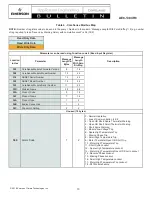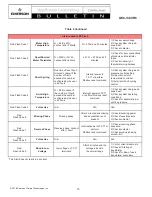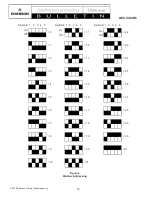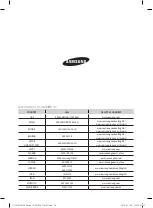
7
© 2018 Emerson Climate Technologies, Inc.
AEX-XXXX
PRELIMINARY
AE8-1384 R6
NOTICE
NOTICE
3. CoreSense History Status Messages
4. Configuration Messages
5. Command Messages
6. Firmware Update Messages
CoreSense status, configuration, history, and device
information messages available to the master include
those listed in
Table 4.
The history status messages give the order in which the
Warning/Alert
has happened, with the total compressor
run time. Information about the
Warning/Alert
occurrence
during the last 7 days and the cumulative
Warning/Alert
counter are also available.
For more information on CoreSense Communications
features and to request Modbus maps please contact your
Application Engineer.
DIP Switch Configuration
DIP switch selection for the Modbus address, baud rate,
parity, and other operating conditions simplify service and
start-up procedures.
Table 5
lists the purpose of each
switch.
The module must be reset after changing any of the
DIP switch settings for changes to take effect.
CoreSense Communications modules are shipped from
the factory with the DIP switches set to default settings for
standalone operation. Default settings are shown in
Table
5.
Switch 1 is turned “on” as part of a quality control check
to verify communications capability of the module before
it leaves the compressor manufacturing plant. Switch 9 is
also turned “on” for TE* motor code. All other DIP switch
default settings are in the “off” position.
If DIP switch settings are inadvertently changed, the
compressor will operate, but could have some loss
of protection. Scroll temperature protection and short
cycle protection could be disabled.
The following steps cover the DIP switch settings throughout
the commissioning process for a multiple compressor
system with communications.
1.
Switches 1 through 5 are used for setting the device
address. DIP switch 1 is the least significant bit (LSB)
and switch 5 is the most significant bit (MSB). DIP
switch addresses 0 through 31 are shown in
Figure
4
. Each CoreSense Communications module that is
daisy chained and connected to a master controller
must have a unique node address (as determined by
the DIP switch settings).
2. Switch 6 defines the communication baud rate for the
CoreSense Communications module. If the switch is
“off”, the baud rate is 19200. If the switch is “on” the
baud rate is 9600. The baud rate of each CoreSense
Communications module should be set to match the
master controller baud rate.
3. Switch 7 defines the communications parity. The default
parity setting for the CoreSense Communications
module is no parity.
If the switch is set to “on” the
module will communicate using even parity. The parity
setting must match the parity setting of the master
controller.
4. Switch 8 defines the control mode. The default setting
is standalone mode (off). If communications with a
master controller is desired, switch 8 should be turned
“on” to network.
5. Switch 9 defines the thermistor configuration. If the
compressor has a voltage code of TE*, the compressor
has PTC and NTC thermistors for motor and scroll
temperature protection. If the compressor voltage code
is TW*, the compressor has only PTC thermistors for
motor and scroll temperature protection. The default
setting is
“on” for PTC and NTC thermistor types.
6. Switch 10 enables short cycling protection if turned
“on”. The default setting is “off”.
Jumper Setting
CoreSense Communications modules are shipped with
the jumper installed. For standalone operation the jumper
should remain installed. For daisy chained applications
the jumper should remain installed for the modules on the
ends of the daisy chain. All other jumpers in the sequence
of daisy chained modules should be removed. The jumper
can be removed using miniature electronics needle nose
pliers
PC Interface Software
PC interface software is available from Emerson On Line
Product Information (OPI). The PC interface software
allows the design engineer access to status, configuration,
history, and data logging via a computer. This method of
connecting and communicating with CoreSense is very
helpful during the unit development stage if CoreSense is
in stand-alone mode and not communicating with a master
controller.
NOTICE
NOTICE





































